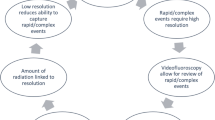Abstract
Temporal parameters such as stage transition duration, bolus location at swallow onset, and pharyngeal transit time are often measured during videofluoroscopy, but these parameters may vary depending on assessment instructions. Specifically, “command” (cued) swallows have been observed to alter timing compared to spontaneous (noncued) situations in healthy older adults. The aim of our study was to confirm whether healthy young people show timing differences for thin liquid swallows between cued and noncued conditions. Twenty healthy young adults swallowed 10-cc boluses of ultrathin barium in videofluoroscopy. The cued condition was to hold the bolus in the mouth for 5 s before swallowing. Three noncued swallows were also recorded. In the cued condition, bolus advancement to the pyriform sinuses prior to swallow initiation was seen significantly less frequently. Stage transition durations showed a nonsignificant trend toward being shorter. Pharyngeal transit times and pharyngeal response time (a measure capturing the interval between hyoid movement onset and bolus clearance through the upper esophageal sphincter) were both significantly longer in the cued condition. Our study in healthy young adults confirms findings previously observed in older adults, namely, that swallow onset patterns and timing differ between cued and noncued conditions. In particular, bolus advancement to more distal locations in the pharynx at the time of swallow onset is seen more frequently in noncued conditions. This pattern should not be mistaken for impairment in swallow onset timing during swallowing assessment.


Similar content being viewed by others
References
Molfenter SM, Steele CM. Temporal variability in the deglutition literature. Dysphagia. 2012;27:162–77.
Chi-Fishman G, Sonies BC. Motor strategy in rapid sequential swallowing: new insights. J Speech Lang Hear Res. 2000;43:1481–92.
Daniels SK, Schroeder MF, DeGeorge PC, Corey DM, Rosenbek JC. Effects of verbal cue on bolus flow during swallowing. Am J Speech Lang Pathol. 2007;16:140–7.
Martin-Harris B, Brodsky MB, Michel Y, Lee FS, Walters B. Delayed initiation of the pharyngeal swallow: normal variability in adult swallows. J Speech Lang Hear Res. 2007;50:585–94.
Robbins J, Hamilton JW, Lof GL, Kempster GB. Oropharyngeal swallowing in normal adults of different ages. Gastroenterology. 1992;103:823–9.
Kim Y, McCullough GH, Asp CW. Temporal measurements of pharyngeal swallowing in normal populations. Dysphagia. 2005;20:290–6.
Power ML, Hamdy S, Singh S, Tyrrell PJ, Turnbull I, Thompson DG. Deglutitive laryngeal closure in stroke patients. J Neurol Neurosurg Psychiatry. 2007;78:141–6.
Dunlap WP, Cortina JM, Vaslow JB, Burke MJ. Meta-analysis of experiments with matched groups or repeated measures designs. Psychol Methods. 1996;1(2):170–7.
Leonard R, McKenzie S. Hyoid-bolus transit latencies in normal swallow. Dysphagia. 2006;21:183–90.
Kendall KA, Leonard RJ. Hyoid movement during swallowing in older patients with dysphagia. Arch Otolaryngol Head Neck Surg. 2001;10:1224–9.
Huckabee ML, Pelletier CA. Management of adult neurogenic dysphagia. San Diego: Singular Publishing Group; 1999.
Martin RE, Goodyear BG, Gati JS, Menon RS. Cerebral cortical representation of automatic and volitional swallowing in humans. J Neurophysiol. 2001;85:938–50.
Kern MK, Jaradeh S, Arndorfer RC, Shaker R. Cerebral cortical representation of reflexive and volitional swallowing in humans. Am J Physiol Gastrointest Liver Physiol. 2001;280:G354–60.
Stephen JR, Taves DH, Smith RC, Martin RE. Bolus location at the initiation of the pharyngeal stage of swallowing in healthy older adults. Dysphagia. 2005;20:266–72.
Acknowledgments
Funding support for this study was provided through an NSERC Create Care Award to SM. Additional funding support was received through a Canadian Institutes of Health Research New Investigator award to CMS and from the Toronto Rehabilitation Institute—University Health Network, which receives funding under the Provincial Rehabilitation Research Program from the Ministry of Health and Long-Term Care in Ontario. The views expressed do not necessarily reflect those of the Ministry.
Conflict of interest
The authors have no conflicts of interest to disclose.
Author information
Authors and Affiliations
Corresponding author
Rights and permissions
About this article
Cite this article
Nagy, A., Leigh, C., Hori, S.F. et al. Timing Differences Between Cued and Noncued Swallows in Healthy Young Adults. Dysphagia 28, 428–434 (2013). https://doi.org/10.1007/s00455-013-9456-y
Received:
Accepted:
Published:
Issue Date:
DOI: https://doi.org/10.1007/s00455-013-9456-y




